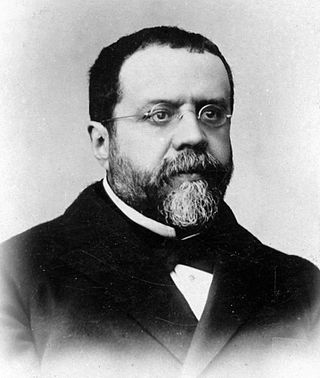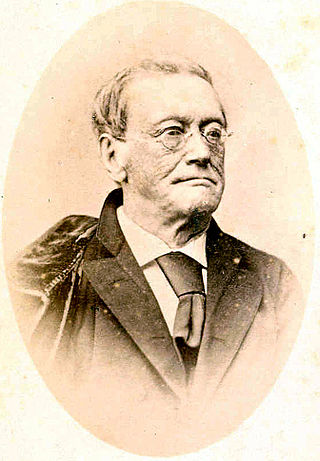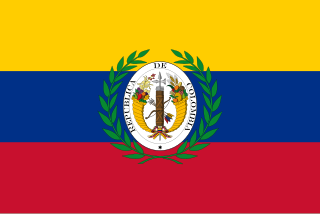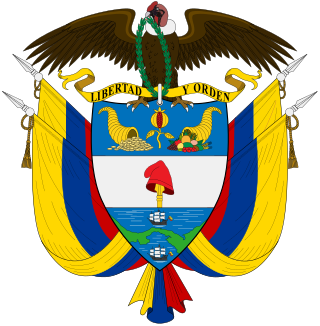
The President of Colombia is the head of state and head of government of the Republic of Colombia. The president heads the executive branch of the national government and is the commander-in-chief of the Military Forces of Colombia.

Rafael Wenceslao Núñez Moledo was a Colombian author, lawyer, journalist and politician, who was elected president of Colombia in 1880 and in 1884. Núñez was the leader of the so-called "Regeneration" process which produced the Colombian Constitution of 1886 which was to remain until 1991.
The Republic of Peru has two vice presidents, the First Vice President and the Second Vice President, who are elected along with the President in democratic elections. Their only constitutional mission is to replace the President in case of death, permanent or temporary incapacity, resignation, being abroad without the permission of Congress, failure to return from abroad at fixed time, and/or dismissal or removal from office as allowed by the Constitution.Note 1 They cannot be appointed outside of general elections.

The vice president of Bolivia, officially known as the vice president of the Plurinational State of Bolivia, is the second highest political position in Bolivia. The vice president replaces the president in his definitive absence or others impediment and is the ex officio President of the Legislative Assembly.

Miguel Antonio Caro Tobar was a Colombian scholar, poet, journalist, philosopher, orator, philologist, lawyer, and politician.

Ramón González Valencia was a Colombian conservative, military officer and statesman. He participated in the civil wars of 1876, Colombian Civil War of 1895, and the Thousand Days War.

José Ignacio de Márquez Barreto was a Colombian statesman, lawyer and professor, who first served as Vice President of the Republic of the New Granada after being sworn in by congress in 1832, and under the presidency of Francisco de Paula Santander, and subsequently was elected President of the Republic of the New Granada for the presidential term of 1837 to 1841.

Gran Colombia, or Greater Colombia, officially the Republic of Colombia, was a state that encompassed much of northern South America and part of southern Central America from 1819 to 1831. It included present-day Colombia, mainland Ecuador, Panama, and Venezuela, along with parts of northern Peru, northwestern Brazil, and claimed the Essequibo region. The terms Gran Colombia and Greater Colombia are used historiographically to distinguish it from the current Republic of Colombia, which is also the official name of the former state.
The constitutional history of Colombia is the process of formation and evolution of the different constitutions that Colombia has had since its formation.

José María Campo Serrano was a Colombian lawyer, general, and statesman, who became President of Colombia after the resignation of the President and the dismissal of the Vice President. He sanctioned the Constitution of 1886 that created the Republic of Colombia proceeding the United States of Colombia. A Samarian Costeño, he became president of the Sovereign State of Magdalena, and Antioquia, Governor of Panama, and held various Ministries during his career as a politician.

The vice president of Paraguay is the person with the second highest position in the executive branch of the Paraguayan government, after the president of Paraguay. The position of vice president was created with the Constitution of 1844, although it was the title given to ex officio members temporarily replacing the elected president in case of death or absence, and was not a position elected alongside the president.

The Presidential Designate was a Colombian elected official, chosen by the Senate to ensure the presidential line of succession. The title of Presidential Designate did not bring any official office or duties, its sole purpose was to replace the President of Colombia in case of absence, death, or inability to hold office.

Carlos María Holguín Mallarino was a Colombian lawyer, journalist, and politician, who became Acting President of Colombia between 1888 and 1892, acting in the absence of President Rafael Núñez.
The Convention of Ocaña was a constituent assembly that took place in the Colombian city of Ocaña between April 9 and June 10, 1828. Its objective was to reform the Constitution of Cúcuta and resolve political differences concerning the future of the republic.

The 1900 Colombian coup d'état occurred on 31 July of that year, and consisted of the peaceful seizure of power by Vice President José Manuel Marroquín, who, supported by the Conservative Party and the Liberal Party, overthrew Manuel Antonio Sanclemente, member of the National Party. The coup occurred in the context of the Thousand Days' War, and took advantage of President Sanclemente's delicate state of health, advanced age, and unpopularity.
The Colombian presidential line of succession is the order which the vice president and other members of the Colombian national Government assume the powers and duties of the Colombian presidency upon an elected president's death in office, resignation, removal from office upon impeachment conviction or incapacity.

La Cosiata, also known as the Revolution of the Morrocoyes, was a political separatist movement that broke out in the city of Valencia, Venezuela, carried out by General José Antonio Páez and Miguel Peña Páez on April 30, 1826, fighting for Venezuelan secession from Gran Colombia.

The dissolution of Gran Colombia and the disintegration of its political structures and central government culminated in the creation of three independent countries: the Republic of Venezuela, the Republic of Ecuador and the Republic of New Granada.



















